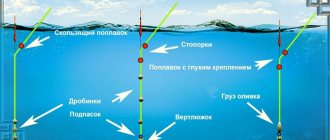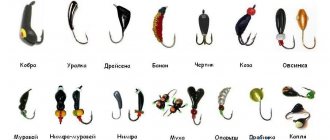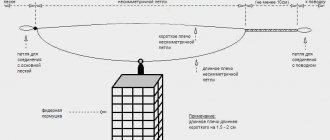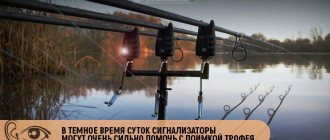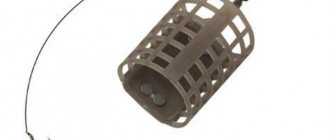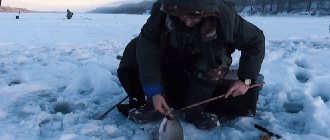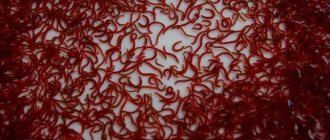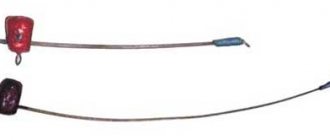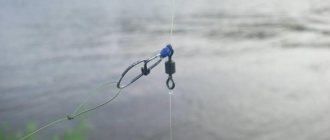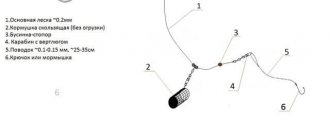In feeder fishing, helicopter rigging is always a source of controversy. Many fishermen use this type of installation in their gear, but in different ways. Some are confident in the effectiveness of this equipment, while others argue that it is no different from a regular paternoster. Mounting a helicopter for a feeder can be used in various fishing options and conditions. Accordingly, depending on these conditions, the features of equipment and fishing techniques change. Let's take a closer look at what helicopter gear in a feeder is and how to use such equipment depending on the conditions of the reservoir and the fish bite.
Feeder equipment
Many anglers use a helicopter feeder rig, some of them claim that this is the best feeder rig in principle. However, any type of installation has its connoisseurs. The truth is that there is no better editing. Each piece of equipment can perform differently on different bodies of water under different fishing conditions. The best option for the feeder is to know and use various equipment depending on the situation, selecting the most suitable one for these specific fishing conditions. The helicopter was invented in order to improve the shortcomings of the paternoster (or rather, borrowed from marine equipment), however, the result was an effective independent equipment that allows you to fish with a feeder not only from the bottom, but also with falling bait. Article about installation of feeder gear:
Carp montages
Hair rig
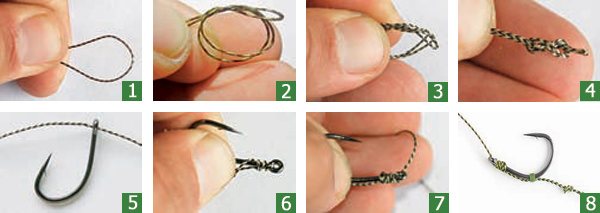
hair making process
An original method of carp mounting, in which the bait is attached not to the hook, but to a small leash extending from it. This type of equipment allows you to effectively catch wary fish that may be spooked by a metal hook inside the nozzle.
The production of such installation is carried out in 3 stages:
- A monofilament or braided cord is inserted into the eye of the hook, retracted a short distance and tied with a small loop.
- Then , the same fishing line is used to fix the hook.
- The loop around the hook is tightened so that the additional leash is 3–5 cm long.
The advantage of this installation is that the bait located in the loop is swallowed by the carp, which takes the bait without fear, and with further absorption or when the fish, feeling the fishing line, tries to free itself from the bait, the fish is hooked.
Sliding equipment
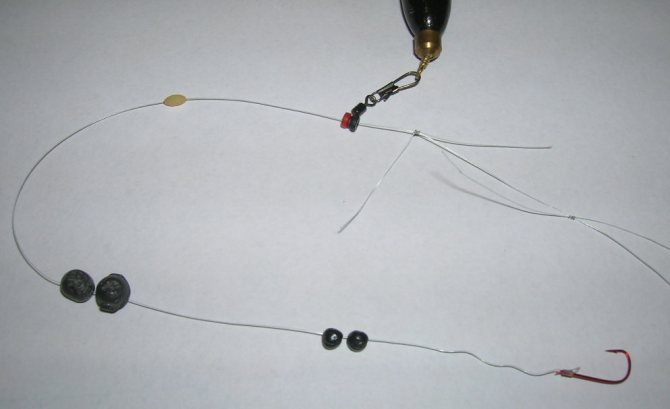
It is the most catchy , due to the fact that the fish does not feel the resistance of the sinker when biting and can move away a considerable distance, which allows the fisherman to hook the prey more effectively.
The installation process is very simple and is carried out in the following sequence:
- on the main line .
- to the tube , to which the sinker is attached.
- Then a leash with a hook is attached to the main line.
Such equipment makes it easy to replace the sinker when necessary. When fishing in a significant current, to securely fix the bait in one place, you should use a heavy, flat-shaped lead sinker.
Safety clip
This method of installing carp gear allows the fish to easily free themselves from the sinker or feeder when the main line breaks. The use of this installation in a section of a reservoir with a snagged bottom does not protect the tackle from possible snags. To minimize this probability, it is necessary to use special offset hooks in such places.
Installation of the safety clip is carried out in the following order:
- A sinking tube about 30 cm long is installed on the main fishing line.
- The line is passed through the cone-shaped coupling and pressed into the tube.
- A swivel and a cone coupling are installed on the clip
- Place the swivel on the end of the fishing line.
- Thread the swivel into the clip.
- Install a leash with a hook on the swivel.
The equipment is ready!
Helicopter

A very interesting and catchy type of carp rig. Particularly good results can be obtained by using this equipment in the current.
This installation is carried out as follows:
- A monofilament 70–80 cm long is tied on one side into a loop into which a swivel with a carabiner is installed.
- on the fishing line .
- On the other side, a stopper in the form of a bead is placed on the fishing line.
- A leash with a hook , equipped with a swivel, is installed on the tube so that the entire structure rotates freely around the main fishing line.
- to the carabiner , which is attached to the bottom of the fishing line.
This carp rig allows you to cast the bait over a long distance due to the fact that the sinker is in front of the equipment when casting.
Inline
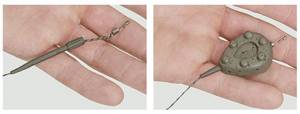
This equipment allows you to successfully catch carp both with conventional tackle with a sinker and using a feeder feeder. The high catchability of this rig is explained by the fact that the fish do not immediately feel the resistance of the sinker or feeder.
The carp calmly swallows the hook with bait, and when trying to move away from the location of the tackle, a self-hooking occurs.
Installation of this equipment is carried out in the following sequence:
- from monofilament with a diameter of 0.5 - 0.7 mm, on one side of which a loop is tied for installation on the main fishing line. On the other side, a swivel with a carabiner is attached.
- A sinker with two eyes is attached to a carabiner.
- to the other ring of the sinker . The length of the leash is 20 cm.
- In order to increase the number of effective bites on this tackle, the hook is used with a hair rig.
A significant disadvantage of this installation is the low flight characteristics of this gear.
Helicopter
Structurally, the helicopter rig is similar to a feeder paternoster - a blind sinker (feeder) at the end of the main line and a leash above. The difference is in the way this leash is attached to the base. In a paternoster, the leash is attached to a branch of thick fishing line that goes down below the feeder trough. This was done so that when reeling out the tackle, the leash does not twist around the main line and the feeder. In a helicopter, the leash immediately, without retraction, clings to the main fishing line with a noose. As a result, the leash is hingedly attached to the base - during reeling and rotational movements, it does not wrap around the base and the feeder, as it rotates around it at the attachment point. Hence the name – helicopter, or Helicopter Rig.
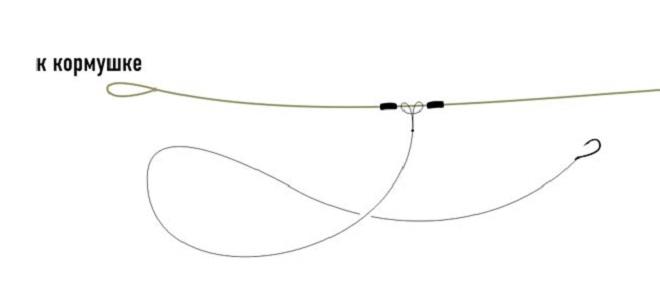
The principle of attaching the leash
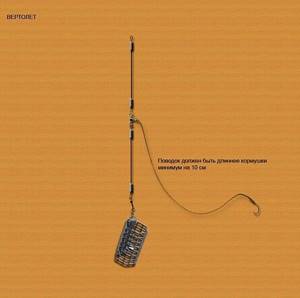
Rough version on a triple swivel (for donks)
To prevent the leash from moving up or down along the main line of the feeder, its section at the point where the leash is attached is limited on both sides by knots or stoppers. If the stoppers are made movable (for example, from silicone stoppers) and movable, then the height of the leash attachment, as well as the possibility of its movement up and down, can be adjusted. Some functions of an asymmetrical or symmetrical loop are obtained - free movement relative to the feeder lying on the bottom. The result is universal equipment. What is the best way to make a helicopter feeder - on knots or stoppers, what kind of leash to use? The answers to these questions depend on what the helicopter will be used for - in classic bottom fishing or with a falling bait. Conventionally, all helicopter installations can be divided into two types according to the purpose of use:
- For bottom fishing, a classic feeder - any of the many options invented by fishermen, with stoppers, knots or with swivels, are suitable.
- A helicopter feeder rig and two knots with long leads for fishing in the current with slowly sinking bait.
The hinged method of attaching the leash to the noose allows you to immediately attach it to its base - without the use of twists, thick bends made of rigid monofilament or fluorocarbon, designed to protect the equipment from entanglement. Because of this fastening on the feeder mounting, the helicopter and two knots rotate when the leash rotates during reeling, and tangling does not occur.
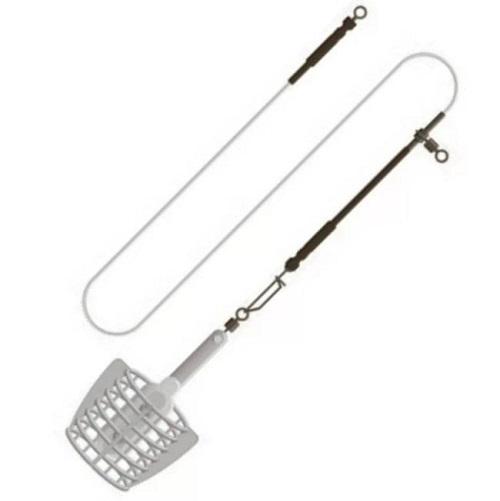
Shop equipment – Baryshev helicopter
How to make tackle correctly
The popular feeder rig, a helicopter and two knots, is considered easy to manufacture. This applies not only to technical aspects of installation, but also to the number of components used. Even a beginner can tie it.
What do the characteristics depend on?
In order for the feeder equipment of the helicopter and two units to have high-quality technical characteristics, it is necessary to carefully consider the choice of materials. The rigidity of the tackle ensures the optimal position of its components on the bottom, and also protects against possible tangling and constant overlaps. For successful summer fishing, try to minimize the size of the hooks and the thickness of the monofilament.
Line selection
Fluorocarbon, which has good rigidity, is suitable for making a helicopter. An additional advantage of such a product is its low visibility and maximum resistance to mechanical damage.
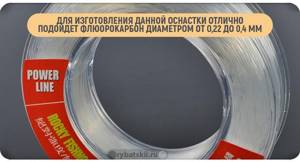
The diameter of the monofilament depends on the mass of the feed and ranges from 0.22 to 0.4 mm. If fluorocarbon is not available, then regular fishing line will do, you just need to choose the stiffest type. Braided gear is not used for assembling tackle due to its excessive softness, because such equipment made from cord and feeder will get confused. Therefore, the helicopter is always knitted separately, and not at the very end of the main line.
The right hook
The correct choice of hook depends greatly on the fishing conditions. This is an extremely important piece of equipment.
The following factors influence the choice of hook:
- the size of the product is selected depending on the type of bait;
- For feeder fishing, the most suitable fish hooks are those with an outwardly curved ring and sting, which are directed along the leash;
- the thickness of the product should be small to reduce the weight of the hook, since fishing occurs with slowly sinking bait.
Only high-quality hooks made by reputable manufacturers should be used. The use of inexpensive analogues will spoil the fishing with constant gatherings and failed attempts to hook prey.
Feeder feeder
During helicopter installation, mesh feeders are mainly used. For maggots and small bloodworms, you can use special cage feeders.
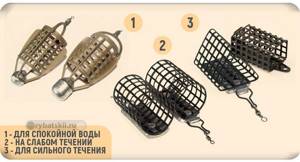
Depending on the strength of the current, the following feeders are used for high-quality equipment:
- For weak currents, light feeders with plastic mesh are used. It is worth making sure that they have stabilizer wings that help them float up quickly, and this reduces the risk of getting caught.
- For fishing in smaller currents, cylindrical-shaped feeders made of iron mesh are suitable.
- In rapid currents, it is customary to use iron feeders in the shape of a rectangle or triangle, because they are not carried away by the flow of water.
For fishing in the current, the mass of the feed should provide a large casting range and good retention of the device on the bottom. Fishing with a helicopter involves self-cutting prey, so it is recommended to use products weighing at least 50 g.
Equipment diagram
The helicopter design is very similar to the Gardner loop, but its main difference is the clear fixation of the feeder and the method of securing the leash. Many fishermen attach it using a free-moving swivel on the monofilament, limited by knots and beads.
But this method greatly complicates production and does not have significant advantages. The use of this option is most suitable for catching carp or bream.
Installation technology
To mount the helicopter, you need to fold a piece of fluorocarbon of the required diameter in half and tie a 15 cm long loop using a double knot.
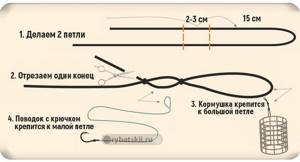
Then a few centimeters are removed from it and another knot is made. The shortest free end of the monofilament is cut off near the knot, and a swivel is attached to the other edge to secure the main line. As a result, the length of the tackle should be about 40 cm.
Cormac is secured in a loop-to-loop manner directly to the installation or using a swivel. The leash is attached in the middle between the knots that limit its movement along the rig. Its length can be in the range of 40 – 60 cm, depending on the degree of prey activity.
Classic helicopter and two knots
Another advantage of the helicopter and two feeder units is ease of installation. The base on the fishing line is knitted in a couple of minutes. And the further use of the helicopter depends on the leashes with which it is equipped.
Helicopter and two knots diagram:
- You can knit both on braid and monofilament. It doesn’t make sense to bother with it and knit it separately, like an asymmetrical loop. We just do it on the main line or shock leader. We fold the fishing line in half and tie a 10-15 cm long loop at the end with a figure eight knot, as in the Gardner paternoster. Here we will use a noose to hook the feeder into the eye of the swivel.
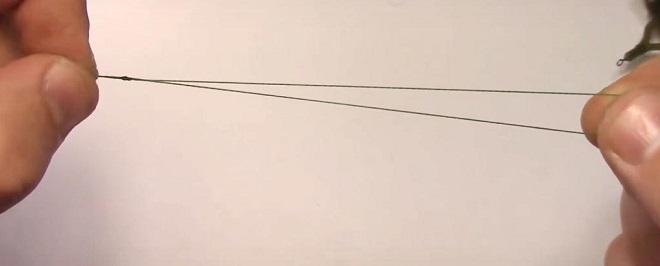

Figure eight knot - We retreat 2-3 cm and tie another similar knot - this will be the area between the two knots for attaching the leash. We cut off one end, the second - to the main fishing line. That's it, the helicopter feeder installation and two nodes are ready. You can use it constantly, assemble and disassemble the feeder - the bundle fits perfectly through the quivertype rings.
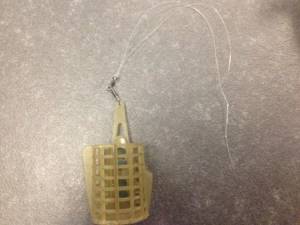
- We fasten the leash with a noose
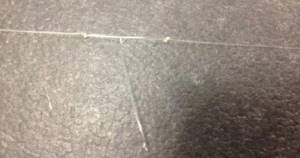
- Ready installation
Depending on the equipment, the helicopter and two units for the feeder with leashes and further fishing takes place. Options are selected depending on the purpose of fishing:
- Short powerful leashes in still water - for catching carp and large crucian carp, when you need the hook with the nozzle to lie on the bottom not far from the feeder.
- Standard leashes, thin, 0.7-1.5 meters long - for classic feeder fishing for white fish in the current, like with a paternoster or a Gardner loop. The stream places the bait in the feed stream below the feeder trough at an appropriate distance. To catch large fish with a feeder in this way, you need to use a monofilament fishing line - the cord does not stretch, the equipment does not absorb shocks, and a thin leash is easy to break when fishing.
- Fishing with a feeder using a floating bait. During the current, a long leash can fall to the bottom within a minute or two. This may be enough for fish pecking in the thicker water above the bottom to find the bait. This method of fishing is only possible with this particular equipment, so a helicopter significantly expands the feeder’s capabilities. Bottom tackle does not always mean fishing from the bottom. Let's look at this issue in more detail - sometimes this fishing method works, especially in the spring, when the bait lying on the bottom does not bring a bite at all.
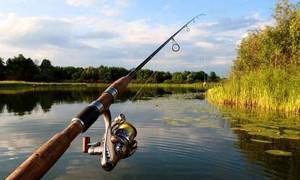
Feeder fishing with falling bait
Of all the rigs, it is the helicopter feeder rig that is most suitable for such fishing. In order for the bait to sink to the bottom as slowly as possible in the bottom rig, you need to maintain the following points:
- The attachment point of the leash to the base is above the feeder. We remove the inline, symmetrical loop. What remains is the asymmetrical, paternoster, inline with bend and helicopter.
- A thin leash should move away from the base immediately, without heavy weighting components - fluoro bends, twists, as all this speeds up the fall of the bait to the bottom. Actually, on all remaining feeder installations, except for the helicopter, there is such a bend or twist. Therefore, there is only one option left - a helicopter.
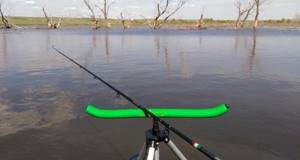
The absence of such a shoulder in the form of twisting or retraction increases the sensitivity of the feeder equipment. However, the bite in this case is short, since the fish feels the resistance of the equipment. The “speed” of a helicopter to bite is even higher than that of a paternoster. Therefore, fishing with such equipment requires constant control, selection of the correct moment of hooking, literally with your hand on the butt of the feeder rod.
The sinking time of the hook also depends on the length of the leader, the diameter of the fishing line and its buoyancy. The thickness of the wire from which the hook is made and the properties of the bait also directly affect buoyancy. The fisherman needs to ensure that the hook, after casting in the current, sinks to the bottom for at least 40 seconds. In general, it is quite calm in a current of medium strength and even more than two minutes of floating the bait can be achieved. If during this time there is no bite, you can lift the rig with a feeder and pull the bait on the hook back into the water without re-casting.
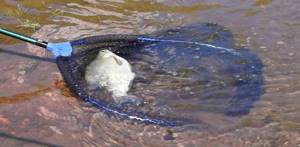
Features of the fishing process
The fishing technique consists of selecting all these components, depending on the strength of the current and the level where the fish takes it. It is necessary to increase the falling time - lengthen the leash, up to 2.5 meters, choose a less heavy fishing line (this is why fluorocarbon will not work - it sinks), set smaller hooks and made of thin wire. Long feeder rods, from 3.9 meters or more, allow you to work with hook overhangs of more than two meters. The lighter the nozzle with the same volume, the better it floats in the water. For example, maggots or bloodworms drown more slowly than heavy dung worms. To increase the buoyancy of a maggot, you need to inflate it. To do this, put a little water in a jar with larvae - a 1-2 mm layer, so that the maggot is wet, but does not drown. In this case, the larvae take in air (reflexively - so as not to drown if it supposedly rains). Such inflated maggots may generally have positive buoyancy.
After casting, you need to periodically tap the feeder on the bottom - in this case, the nozzle on the hook will also make certain vibrations. This fishing method is indispensable for roach, bluefin, sabrefish, rudd, and chub. Even bream, crucian carp, fisherman and silver bream sometimes prefer to take the bait not at the bottom, but above it in the water column (especially during spring spawning trips or in muddy water). If necessary, you can also raise the attachment point to the main fishing line by making a section with knots not 15 cm from the feeder, but 30.
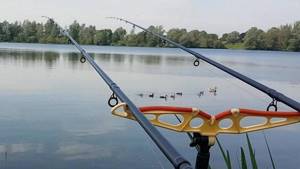
Some fishermen use a feeder arm length of up to 70 cm. However, the greater the arm length on the feeder, the greater the likelihood of entanglement during long casting. If fishing takes place underfoot, such as a ledger feeder - with casting from under a skirt, you can attach the leash 1.5 meters from the feeder. Then, when casting the feeder away from you, like a fishing rod, we hold the rig by the leash, and not by the feeder. In this case, the feeder moves forward under its own weight and flies first when the leash is released, which after splashdown is simply pulled out with the flow. This method is useful when fishing in narrow, deep rivers and channels with half-water flow.
Fishing from the bottom
The helicopter feeder rig from the bottom in standard mode works the same way as a paternoster - only it has “anti-twist” measures not in the form of retraction or twisting, but by hingedly attaching the leash with a noose. In all other respects, everything is the same. A helicopter is preferable to a paternoster if the fish is careful, and fishing is done with short leashes, 30-50 cm. For regular fishing, it is better to use a helicopter feeder tackle not with knots, but on mobile stoppers. This makes the feeder rig more versatile - depending on the fishing conditions, you can move the leash attachment point higher or lower, as well as expand the segment between the nodes, increasing the length of free play along the main line.
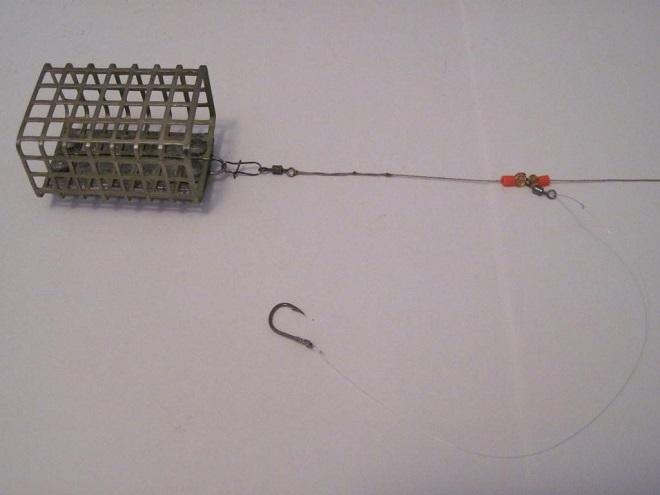
Advanced helicopter
The capabilities of the improved helicopter are much greater, because by moving the stoppers along the monofilament, you can greatly expand the fishing area. To prevent spontaneous slipping of the swivel, it is recommended to install several beads on each side as stoppers.
To assemble an improved helicopter, you must perform the following steps:
- stop beads, a swivel, and then beads again are installed on the fluorocarbon;
- a fixing knot is made slightly below the outer bead;
- After a certain distance from the knot, the cormak is tied: this is done through a carabiner, attached directly to the main fishing line or through a loop;
- a leash of the required length is attached to the other ring of the swivel using the “loop to loop” method.
Sliding helicopter on stoppers
It makes sense to do a sliding helicopter on stoppers on a monofilament line (shock leader) of the feeder, since their diameter is usually about 0.3 mm. When you put small silicone stoppers on such a monofilament, they move with great difficulty. On a thin braid, the stops will slide unauthorizedly, for example, down to the feeder during fishing, and they will have to be adjusted every time. On a thin fence, it is advisable to use two knots, installing stoppers in front of them. It’s just that the knots on a thin cord when knitting the installation turn out to be small, and by adding stoppers we protect the feeder leash from slipping through them.
The helicopter equipment for the feeder on sliding stops is universal. And it works like a paternoster. In this case, you need to choose the smallest stoppers so that they pass through the quivertype rings. Then it is convenient to assemble and disassemble the feeder with the equipment pre-tied on the fishing line. We use stoppers to select the required distance from the feeder, and set the leash depending on the necessary equipment in specific fishing conditions. That is why many fishermen love this feeder installation, especially those who do not like to bother too much with tying various equipment.
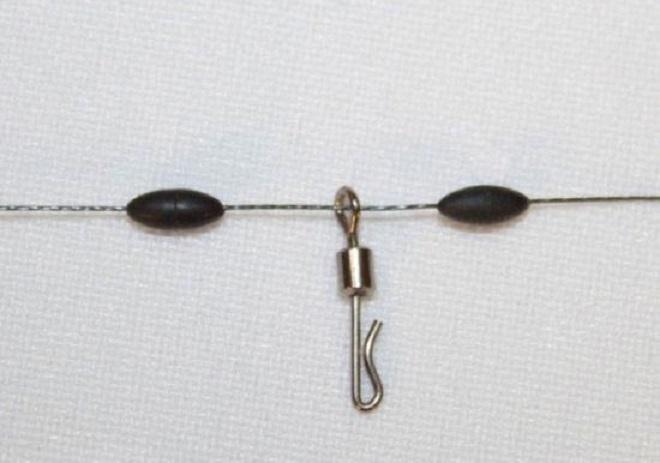
Two stoppers and a swivel are an option. Instead of a swivel, you can simply hook the leash with a noose
Fishing with a "Helicopter" for a feeder
Being at some distance from the feeder, the bait hangs in the middle of the water layer under the influence of the current.
To achieve a natural falling effect, you can change some components of the device:
- leash length;
- hook size;
- nozzle weight.
In order to successfully use the equipment, it is necessary to take into account some nuances when fishing:
- It is recommended to first accustom the fish to the feeder in the place of intended fishing. To do this, you need to feed it with several casts of a feeder for fishing without a hook on a flowing reservoir with a strong current.
- To attract fish, you should use light baits, for example, moths or maggots, so that the hook can hang in the water column of the reservoir or sink to the bottom, but slowly and smoothly.
- Tapping the tip of the rod attracts bait because it creates the effect of a living object.
- By placing the swivel with the leash between the silicone clamps, you can adjust the distance from the leash to the feeder.
- The bite occurs with a sharp movement due to the fact that the fish is hooked at the moment the feeder jerks.
carp helicopter
The helicopter principle came to the feeder from carp fishing (and there from sea fishing). A helicopter, or helicopter rig, is a very popular equipment among carp anglers. More details - a helicopter for carp fishing. In its pure form, the carp helicopter is more powerful; it is tied on leadcore using crimp tubes to ensure that the leader does not get tangled. This type of rig works great for long power casts and doesn’t get tangled.

In the feeder version - an ordinary helicopter with a leash 20-30 cm long made of fairly strong monofilament - depending on who we catch. You can put 0.3 mm on trophy carp. For catching with a feeder an ordinary river carp or carp up to 3 kg, large crucian carp, 0.2 mm is enough, provided the main line is made of monofilament and a good drag on the reel.
Subscribe to the channel:
YouTube channel RYBAFAN
We are VKontakte
Carp fishing methods
On a float rod
The most productive time for carp fishing is considered to be:
- before dawn;
- then from about ten until lunchtime;
- before sunset;
- an hour before sunset.
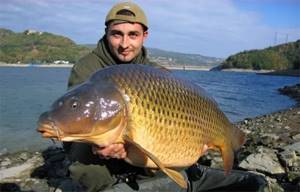
The basic rule is reliable and massive gear. Fishing rods are:
- plug;
- match;
- flywheel
The desired length is from 5 to 6 m, and we also need:
- a spinning reel with a good friction brake and 4000–4500 m of line;
- It is advisable to have a fishing line for large fish (0.3 mm);
- You need to choose a high-quality hook and not too big;
- float, of any shape, but can withstand a heavy sinker; it is best to use a float with a variable load.
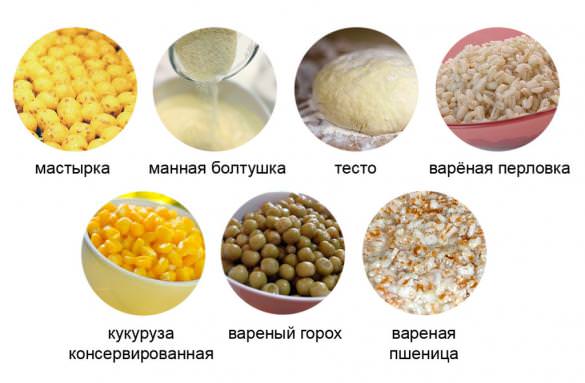
Complementary feeding for carp
This fish is too picky, so the bait should be varied. In summer you can use:
- peas;
- barley;
- dough, etc.
In spring use:
- maggot;
- worm;
- bloodworm.
In the fall it can bite on everything.
Once you've chosen your fishing spot, make a test cast to measure the depth. The fish likes to try the bait first, the float will warn you about this, but if it suits your taste, there will be a sharp bite, at this time you need to hook it, if this succeeds, then the fish will try to move away, and the result will now depend only on you . When she is exhausted, you need to bring her to the shore and take her into the landing net.
On a plug rod
It is one of the longest, more than 10 meters, consisting of collapsible sections. They are made mainly from carbon fiber, with fiberglass sometimes added. The main part is called a whale, it can be removed, its length reaches 6 m.
The plug rod has no guides
It occupies a special place in fishing because it is effective, despite its bulkiness and slight inconvenience during use. But with its help you can transmit the bait very accurately, even over considerable distances. Previously, it was used only for sporting competitions, but anglers gradually came to appreciate this almost always successful method of fishing. You just need to handle it carefully, due to its fragility, and try to avoid blows.
On a fly rod
It has 2 undeniable advantages:
- almost weightless;
- quite affordable price.
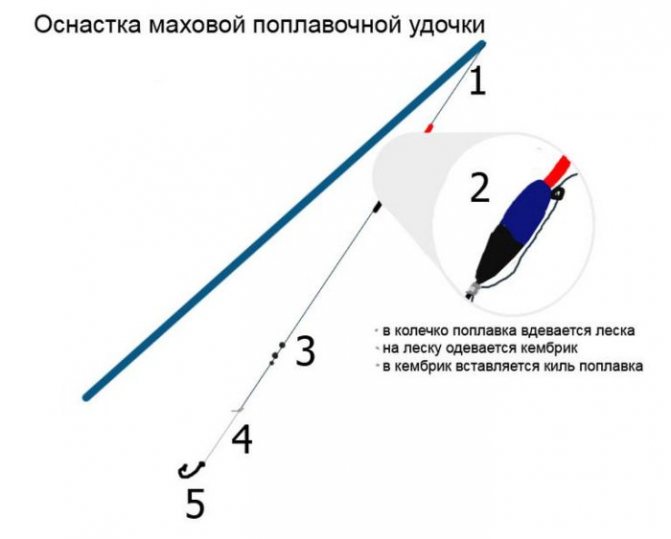
A distinctive feature is its strength; you will be sure that your fishing rod can handle any fish. If used with this kit:
- blind installation;
- light floats;
- thin lines.
Then you will not only increase your chance of catching, but you will also not be able to scare away more experienced specimens. It has become widespread recently. It is a telescopic fishing rod over 5 m. A connector is attached to the top using glue - it is needed so that you can tie the fishing line to the tackle.
This fishing rod is equipped traditionally: float, fishing line, sinker, hook.
An interesting feature is the tip with a connector, thanks to which you can easily change rigs; you just need to wind the fishing line and tie another one.
You need to start fishing in favorable weather and feed the place.
You can buy bait mixture at the store. Or you can do it yourself:
- oat flakes – 200 g;
- corn and hemp grains – 500 g;
- bran – 400 g;
- bread waste (1 kg);
- water.
They are caught at a depth of 0.5 to 2; first, using a fishing rod, you need to determine the depth. Make the distance from the float to the hook 1 meter. This is called launching and throwing into the water. If the float sinks, it means it is deeper than 1 m, and if it lies, then it is shallower.
It is advisable to choose a place right away that will delight you with good bites for many years. The casting technique resembles a regular fishing rod, differing not only in weight and size, but also in ease of use. Due to its design and good flexibility, it creates an impeccable hook in the fisherman’s desire to pull the carp out of the water.
On a match rod
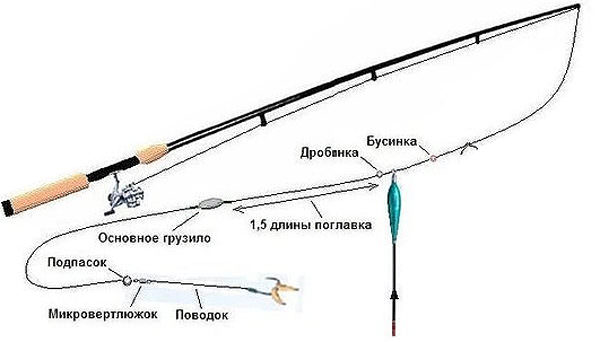
Structure of a match fishing rod
This rod can be used not only in deep waters, but also near the shore, and it will be a pleasure to fish with it. It is equipped with a reel with a brake.
When you go fishing, you should take 2 reels with you:
- on the first, the thickness of the fishing line should be 0.3 mm;
- on the other 0.19 mm.
When you are fishing for fish, try to frequently adjust the tension of your fishing line using the clutch. Use more powerful reels, preferably spinning ones.
To the feeder
It is used for fishing from the very bottom, equipped with a special feeder; such a place must be fed.
They are divided into groups by weight:
- pickers (up to 3 m);
- heavy pickers (cargo weight from 90–120 g);
- average 35–40;
- lungs 4–35;
- feeders (more than 3 m).
And the weight of the thrown load itself ranges from 30 g in light ones to 100 g in super-heavy ones.
There are many different types of equipment for catching carp on a feeder, for example, “Method” feeders , which are recognized all over the world. One of the options for such feeders is flat-bottomed, or the “flat” method.
Feeder Method
The main superiority lies in the structure:
- consisting of a sinker, which in its shape resembles a petal;
- reinforcing elements for bait were made.
Its design is such that when lowered to the bottom, it always falls with the sinker down and the bait up. There are several methods of application:
- Deaf : the feeder is attached to the fishing line and when biting it helps to hook the fish, it is advisable to use feeders from 35 g.
- Sliding : usually used in feeder fishing and the bite is sent to the tip, the feeder easily moves along the line, self-hooking is impossible.
If you install a rubber stopper, then with its help you can quickly fix the feeder, and it can also slide along the fishing line. They also make a hair rig, and bait can be hidden in it.
Installation diagram of the “Helicopter” equipment for donkeys in the current
Before moving directly to the “Helicopter” feeder installation diagram, answer - how many feeder rigs do you know and which ones do you use when fishing with a donk in the current?
Why such demand? Everything is very simple.
Feeder rigs were initially created for certain fishing conditions and the availability of specialized gear. However, there are many more bottom fishing enthusiasts and not everyone uses feeder rods. Spinning in its various modifications is commonplace.
Often these are short, on average 240, sticks, which sometimes makes it difficult to use the original installation “a la feeder”.
If we consider fishing in the current, then most feeder rigs require a fairly large overhang of leashes with hooks. Otherwise, the meaning of the montage is lost. The feeder should maintain the position at the bottom of the reservoir in the designated place, and the bait should be presented to the fish more naturally. And it is the long leashes that ensure the hook with bait slides smoothly to the bottom and oscillates in time with the movement of the water.
Yes, and making a high-quality and correct cast when the leash is more than 50 - 80 centimeters below the feeder or sinker is only possible with rods of sufficient length. The same cannot be said about commonly collected donks. It’s good if the spinning tackle is somewhere around 2.70. With such a length there are usually no problems. And when the spinning rod is 2.10 - 2.28, at best 2.40? And this is the most popular fishing rod size.
How do we get out of this situation? Either we completely avoid editing or make a truncated version of it. As a result, the meaning of the equipment once created by the master is not revealed, and we deprive ourselves of the pleasure of catching a cautious and potential trophy.
Fortunately, there are options for feeder ties that work well not only with the “correct” rod, but also with shorter sticks and medium-length leashes. I can safely include the Gardner loop and its close relative - the “helicopter”, or, to put it in full, “a helicopter and two knots”.
Helicopter equipment for feeder - installation and use
In feeder fishing, helicopter rigging is always a source of controversy. Many fishermen use this type of installation in their gear, but in different ways. Some are confident in the effectiveness of this equipment, while others argue that it is no different from a regular paternoster. Mounting a helicopter for a feeder can be used in various fishing options and conditions. Accordingly, depending on these conditions, the features of equipment and fishing techniques change. Let's take a closer look at what helicopter gear in a feeder is and how to use such equipment depending on the conditions of the reservoir and the fish bite.
